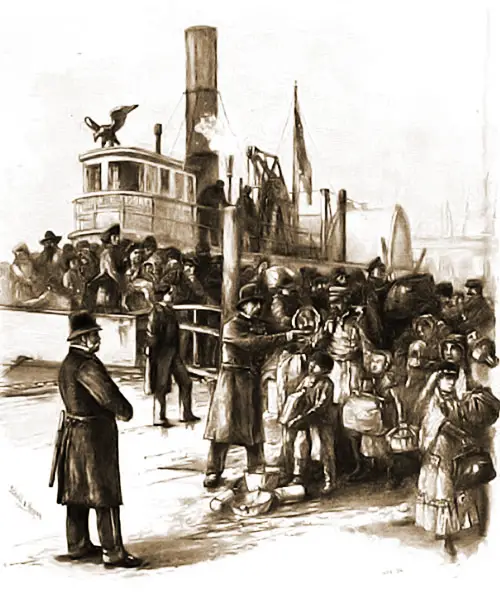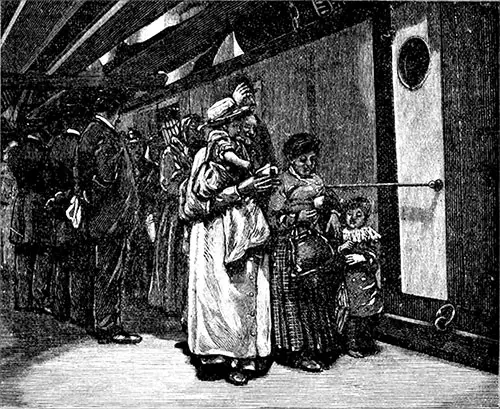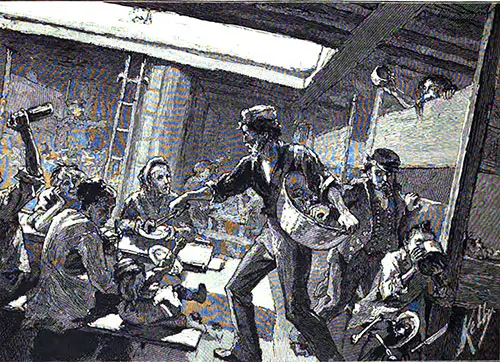Journey In Steerage from Northern Europe - 1871

Landing Immigrants at Castle Garden in 1871
Preface
Article from 1871 describes the conditions steerage passengers endured during their journey to the new world. It also provides a summary of the accommodations and management of steerage passengers by the principal steamship lines of that period.
The article also provides information for family history researchers including Tonnage and Horsepower of Steamers; Ports of Embarkation and Debarkation; Rates of Passage for Steerage Passenger; Average No. of Steerage Passengers carried in a Steamer; and Space allowed each Passenger for Luggage for the steamship lines as of 1871.
General Directions for Emigrants
Steamships are far preferable to sailing vessels for the voyage. The former makes the passage in from ten to fourteen days, while the latter requires from four to eight weeks.
The rates of passage are generally lower on sailing than on steam vessels, but the difference is not significant enough to compensate for the loss of time and the hardships of a long voyage.
The accommodations, especially the food, are generally much better on steamships. Nine-tenths of the emigrants to the United States already come by steamers, and it is believed that sailing ships will soon entirely cease to be employed in carrying them. In 1869 steamships lost only one in a thousand passengers, while sailing vessels lost one in two hundred. This shows how much safer the former is.
To reach the port of embarkation, if the emigrant is not already there, requires information, which can be entirely given only on the spot, and we do not here attempt it. At most, of the steamship agencies, which are scattered over Great Britain and Northern Europe, tickets may be purchased to cover the expense of the journey to the port.
The purchase of tickets requires caution. The emigrant must take care that he goes to the Steamship Agent's office, and gets the appropriate ticket at the proper price.
We now give a table in which the various steamship lines are enumerated; with details concerning their management as far as steerage passengers, that is, emigrants, are concerned.
Management of Steerage Passengers by Steamship Lines
Anchor Line
- Tonnage and Horsepower of Steamers: From 1,000 to 3,300 tons, and from 400 to 1,200 horsepower
- Agencies in Europe and the United States: Handyside and Henderson, Glasgow and Londonderry; Henerson Bros., Liverpool, Christiania, Gothenburg, and New York
- Ports of Embarkation and Debarkation: From Glasgow to New York, touching at Londonderry, Ireland, Run in connection with the Anchor Lines of North Sea Steamers to Norway, Sweden, and Denmark
- Rates of Passage for Steerage Passenger: From Glasgow, Londonderry, and Liverpool, £6 6s. From Gothenburg, Copenhagen, and Christiania, $38 USD. From Hamburg, Antwerp, and Rotterdam, $36 USD.
- Average No. of Steerage Passengers carried in a Steamer: 500
- Space allowed each Passenger for Luggage: 20 cubic feet. The company assumes no responsibility.
Cunard Line
- Tonnage and Horsepower of Steamers: From 2,000 to 4,000 tons, and from 280 to 1,000 horsepower
- Agencies in Europe and the United States: D. & C. MacIver, Liverpool and Queenstown; G. & J. Burns, Glasgow; S. Sorensen, Gothenburg; Christian Stapel & Co., Copenhagen; F. Preus, Christiansand; M. Otto U. Müller, Hamburg; Chas. Bürnstein, Bremen; J. Hartmann & Co., Antwerp; J. De Waal, Rotterdam; Charles C. Franklyn, New York; Jas. Alexander, Boston
- Ports of Embarkation and Debarkation: From Liverpool to Boston, touching at Queenstown and Halifax; and to New York, touching at Queenstown
- Rates of Passage for Steerage Passenger: From Liverpool, Queenstown, Glasgow, or Londonderry, to Boston or New York, £6 6s. From Gothenburg, Christiania, or Copenhagen, $38 USD, From Hamburg, Antwerp, Havre, or Rotterdam, $36 USD
- Average No. of Steerage Passengers carried in a Steamer: To Boston in 1870, 347. To New York in 1870, 365
- Space allowed each Passenger for Luggage: 10 cubic feet.
Hamburg Line [Hamburg America Line]
- Tonnage and Horsepower of Steamers: From 3,000 to 3,500 tons
- Agencies in Europe and the United States: Hamburg: August Boltren; Havre: A. Brotstroem; London and Southampton: Smith, Suudius, & Co.; New Orleans: Williams, Ruperti, & Co., Maury & Co.; Havans., D. Erdmann; New York: Kunhardt & Co.
- Ports of Embarkation and Debarkation: From Hamburg to New York, stopping at Havre, and stopping at Plymouth and Cherbourg on the return trip. Steamers are to run between Hamburg and New Orleans, stopping at Havre and Havana.
- Rates of Passage for Steerage Passenger: From Hamburg to New York or New Orleans, 55 thalers (Prussian currency). From Havre to New York or New Orleans, 210 francs
- Average No. of Steerage Passengers carried in a Steamer: 492
- Space allowed each Passenger for Luggage: 10 cubic feet
Inman Line
- Tonnage and Horsepower of Steamers: 2,700 tons
- Agencies in Europe and the United States: Wm. Inman, Liverpool; Alex. Malcolm, Jr., Glasgow: Cornelius Carlton, Dublin; Herman Roos, Gothenburg; P. M. Kolle, Copenhagen; H. Heitmann, Christiania; Falck & Co., Hamburg; H. Danelsberg, Bremen; Wm. Inman, Antwerp; Ruys & Co. Rotterdam; John G. Dale, New York; M. S. Creagh, Boston.
- Ports of Embarkation and Debarkation: From Liverpool to Boston, touching at Queenstown and Halifax; and to New York, touching at Queenstown
- Rates of Passage for Steerage Passenger: Gothenburg, Copenhagen, and Christiania, $45 USD, From Hamburg, Antwerp, and Rotterdam, $40 USD
- Average No. of Steerage Passengers carried in a Steamer: 700
- Space allowed each Passenger for Luggage: 10 cubic feet.
National Line
- Tonnage and Horsepower of Steamers: From 2,956 to 4,500 tons
- Agencies in Europe and the United States: 21 Water St., Liverpool; 69 Broadway, New York, With agencies in Ireland and Scotland
- Ports of Embarkation and Debarkation: From Liverpool to New York, touching at Queenstown
- Rates of Passage for Steerage Passenger: From Liverpool or Queenstown, £6 6s
- Average No. of Steerage Passengers carried in a Steamer: 600
- Space allowed each Passenger for Luggage: 10 cubic feet
North German Lloyd
- Tonnage and Horsepower of Steamers: 3,000 tons, and 700 horsepower
- Agencies in Europe and the United States: H. Peters, Bremen; W. Kennedy, Antwerp; Keller, Wallis & Postlethwaite, Southampton; Oelrichs & Co., New York; A. Schumacher & Co., Baltimore.
- Ports of Embarkation and Debarkation: From Bremen to New York and Baltimore, touching at Southampton. During the summer months, from Bremen to New Orleans, also touching at Havre, Southampton, and Havana.
- Rates of Passage for Steerage Passenger: From Bremen to New York, Baltimore, Havana, or New Orleans, 55 thalers (Prussian currency), From Antwerp to above ports, £9
- Average No. of Steerage Passengers carried in a Steamer: 600
- Space allowed each Passenger for Luggage: 20 cubic feet for adults, 10 for children.
White Star Line
- Tonnage and Horsepower of Steamers: 5,000 tons and 3,500 horsepower
- Agencies in Europe and the United States: This line Is new and not yet in complete operation. The principal offices now are 10 Water St., Liverpool; 19 Broadway, New York. Agencies will soon be established throughout Europe
- Ports of Embarkation and Debarkation: From Liverpool to New York, touching at Queenstown
- Rates of Passage for Steerage Passenger: From Liverpool, £6 6s. From Hamburg or Bremen, 60 thalers. From Liverpool to New York, $33 USD
- Average No. of Steerage Passengers carried in a Steamer: 1,000
- Space allowed each Passenger for Luggage: 10 cubic feet. There is a secure baggage room.
Williams & Guion
- Tonnage and Horsepower of Steamers: 3,000 tons, and 600 horsepower
- Agencies in Europe and the United States: 25 Water St., Liverpool; John Anderson, Gothenburg; H. C. Duhresen, Copenhagen; Blichfeldt & Co., Christiania; Morris & Co., Hamburg; Steinman & Co., Antwerp; J. B. Crol & Co., Rotterdam; 63 Wall St., New York
- Ports of Embarkation and Debarkation: From Liverpool to New York, touching at Queenstown
- Rates of Passage for Steerage Passenger: From Liverpool, £6 6s. From Christiania, 80 Sp. From Hamburg, 45 thalers. From Rotterdam, 75 florine. From Antwerp, 166 francs
- Average No. of Steerage Passengers carried in a Steamer: 1,000
- Space allowed each Passenger for Luggage: 10 cubic feet

Immigrants Passing by the Ships Physician during Onboard Inspection. Frank Leslie's Popular Monthly, June 1892. GGA Image ID # 145c6d2ade
Accommodations for Steerage Passengers
Steerage passengers are furnished, on steamers of all of the above lines, with an abundance of food, of good quality, properly cooked, and served by the companies' stewards three times a day.
This generally consists of fresh bread, tea or coffee, and gruel, if wished, for breakfast and supper, and beef or pork, soup, fish, and potatoes, for dinner.
Passengers must provide themselves, in all cases, with mattress, bedding, plate, mug, knife, fork, spoon, and water can. These can all be procured in Liverpool for fifteen shillings.
Separation of Sexes and Ethnic Groups
On all of the above lines, also, each passenger is assigned a separate berth, and single women are placed in rooms by themselves. The White Star Line puts married couples and single women aft, and single men forward. On Anchor Line, nationalities are kept apart when in sufficient number.
Fares for Children and Infants
A half fare is charged for children under twelve, and $5 for infants under one, on the English lines. On the German lines, the half-fare is charged for children under ten, and three thalers current for infants under one.
Prohibited Items
Passengers are not permitted to carry wares or merchandise in the luggage, and are liable, in case of so doing, to confiscation and punishment. On the North German Lloyd steamers, they must also pay $400 to the ship. Gunpowder is prohibited, and weapons must be deposited with the captain.
Money, or objects of value, may be placed for safekeeping in the captain's or purser's bands during the voyage.

Dinner is Served in the Steerage. Scribner's Magazine, September 1877. GGA Image ID # 147746a1c0
In buying his ticket by any of the above lines, it will be well for the emigrant, if his destination on the other side of the ocean is fixed, to inquire concerning his transportation thither from the port at which he is to land.
Some of the steamship companies make it an object to buy a ticket from the starting-point in Europe to or near the point at which one is to settle in the United States. The emigrant must not take this course without minute inquiry.
Clothing Recommendations for Emigrants
The outfit is another crucial matter. An emigrant ought to have one or more stout boxes, well roped, and plainly marked. He should fill it or them with substantial clothing, including boots and shoes, part for winter, part for summer wear, all costing much more in the United States than in Europe. Clothes of every kind, if in use, or ready for use, pass free at the customhouses.
Some articles may be required for the voyage. Concerning these, the rules of the steamship companies must be consulted. If the passenger has money or valuables, he will do well to deposit them with the purser of the ship during the voyage.
While on shipboard, one must be careful about his food, an abrupt change of diet is terrible everywhere, and particularly at sea. The choice of acquaintances among the passengers should be very cautious, especially on the part of women. Discretion as to intercourse with others is of hourly importance during a voyage.
American Social Science Association. "Part I: General Directions," in Handbook for Immigrants to the United States. Cambridge, MA: Hurd and Houghton, 1871. Pages 1-8.
This work is meant to contain, in a concise form, such information as one proposing emigration requires to decide, first, whether he had better leave his old home, and if so, second, how to settle himself in a new one.
It aims not only at guiding immigrants across the ocean and into the interior of the United States but also at fitting them to become happy and useful citizens in the land of their adoption.
It is intended for distribution by Emigration Agencies in Europe, steamship lines, Hoards of Immigration and State charities, and railroad and land corporations in the United States.
